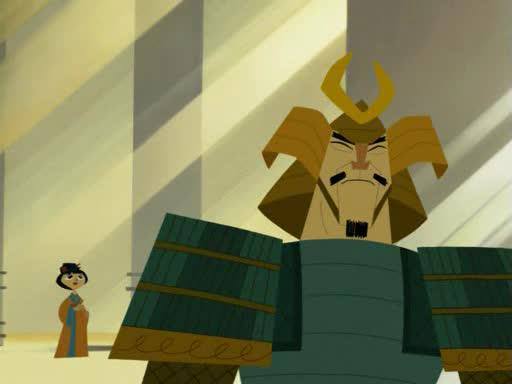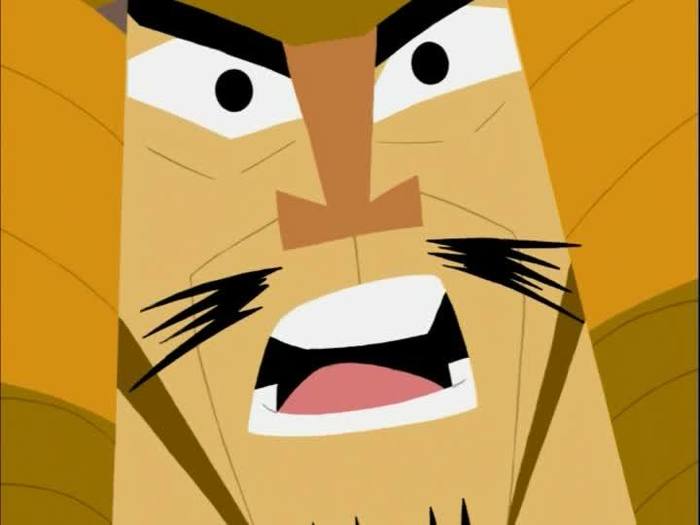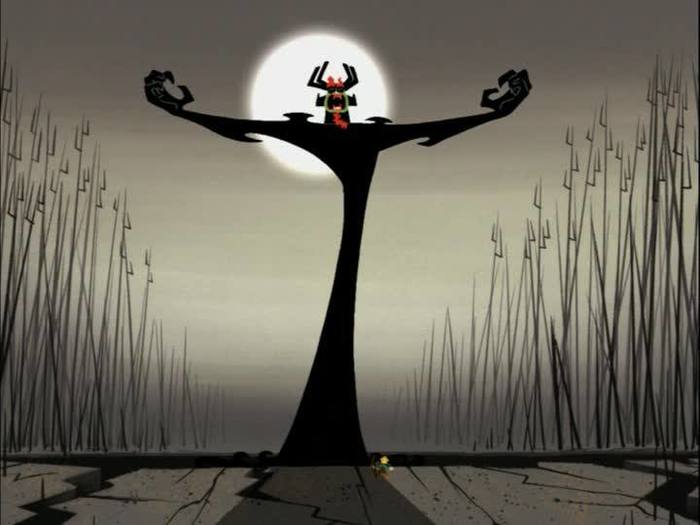Samurai Jack: The Birth of Evil Part One Revisited
My review/examination on Part One of Genndy Tartakovsky's Birth of Evil episodes from Samurai Jack.

Introduction
In the wake of all the news surrounding the Russian-born but USA-based animator Genndy Tartakovsky’s revival of the 2001-2004 animated action television series Samurai Jack, after 12 years of dormancy, and sometime this year or the next, I wanted to pull my focus on one of or if not my absolute favorite episode (albeit a two-parter) of one of my favorite kids cartoons growing up for my first article or two in two years.

It was on a Saturday Night, August 16, 2003—that will be 13 years ago—that a two-part episode of Samurai Jack—created by the Russian-born yet USA-based Genndy Tartakovsky, who is also the creator of the mid to late 1990s kids cartoon series Dexter’s Laboratory and the future director of the two Hotel Transylvania films that features the voice talent of the much-hated comedian Adam Sandler as an overprotective Dracula—aired on the once-popular Cartoon Network. A year later, it would win a Primetime Emmy Award (which is the television equivalent of the Oscars) for Outstanding Animated Program (for Programming less than One Hour), beating such competing episodes as Futurama’s “The Sting”, The Simpsons’ “The Way We Weren’t”, South Park’s “It’s Christmas in Canada”, and Spongebob Squarepants’ “Ugh” (also known as Spongebob B.C. (Before Christ)) in the process.
It is basically something of a prequel to the first three half hours of Samurai Jack collectively known as The Premiere Movie, explaining the origins of Aku, who is Samurai Jack’s nemesis on the show itself, as well as the origins of Samurai Jack’s father’s enchanted sword, and how Jack’s father, the Japanese Emperor, fought Aku and eventually brought about Aku’s “jail time” simply by imprisoning his remains in a huge tree-like “jailhouse” that sticks out amidst the damage that the so called Shogun of Sorrow, Deliverer of Darkness and Master of Masters have wrought upon the Japanese countryside. And of course, it ended with the birth of a child who will one day be called “Jack” in the “future that is Aku”.
The two-part episode in question, which was directed by Genndy Tartakovsky and Robert Alvarez with storyboards also by Don Shank, was called—rather collectively—The Birth of Evil.
And now I begin pulling my focus on the first part of The Birth of Evil (also known as Episode 37 of Samurai Jack) by starting with a rather mythological battle between good and evil during the very beginnings of the universe itself.
The Gods battles the Ultimate Evil

Now, billions and billions of years ago, the universe had just been born, when suddenly, this inky black bob of ultimate evil emerges from a star and then fled through the cosmos, for the Ultimate Evil is not alone, because three gods of rather non-Japanese origins was on the trail left behind by the evil inky blob.

The three gods in question are, respectively: Odin, the supreme god of Norse mythology (also known as Wotan in Richard Wagner’s four-part operatic cycle, Der Ring Des Nibelungen (better known as Wagner’s Ring Cycle)) riding on his eight legged horse Slepnir, and holding a trident here for a weapon instead of a spear; Rama, one of the Avatars of the Hindu deity Vishnu (and the hero of one of the two great Sanskrit epic poems of India, The Ramayana (The other was the much longer, more complex The Mahabharata, which focuses for the most part on Arjuna and his descendants)), wielding a bow and arrows and riding atop a blue elephant; and Ra, the bird-headed Egyptian Sun God riding a Nile Crocodile and wielding a khopesh, a type of sword found in Ancient Egypt. The three Gods chase the Ultimate Evil through the cosmos cornering it with their weapons.
Rama was the first to strike at the Ultimate Evil by firing his arrows from his bow atop his elephant; Next was Ra’s turn to strike at the evil by firing some magic from his khopesh; and finally, Odin fires his trident at the blob, infuriating the monster enough to fight the gods in the form of a crab or scorpion like creature.

An epic battle ensues, and during the grueling fight, Odin slices off a tendril of the Ultimate Evil with his trident, sending it flying towards the recesses of space, just as the three gods finishes off the Ultimate Evil for good.
Arrival on Mesozoic Earth

For over three billion years, the severed tendril of the Ultimate Evil flies across the recesses of space before, sixty-six million years ago, the tendril enters our Milky Way Galaxy before flying past our Solar System and flying towards our future home planet, Earth, which is at a time when the dinosaurs—that other great heavyweight of Evolution—roamed a lush and fertile planet (in a scene that is rather based off on the dinosaur parts of the Rite of Spring sequence of Walt Disney’s wildly ambitious 1940 animated experimental epic film, Fantasia).
(For those interested in dinosaur-themed cinema, the best and closest thing such people would ever get at enjoying the ultimate dinosaur movie experience was undoubtedly Jurassic Park, which Steven Spielberg brought to the screen in 1993 from a 1990 science fiction thriller novel by Michael Crichton; please be advised that dinosaur movies—especially good ones—are very, very hard to do well, since Steven Spielberg’s contributions to dinosaur media such as 1988’s The Land Before Time and the aforementioned Jurassic Park film from 1993 could continue to cast a long shadow on dinosaur media efforts for a very long time to come. That is just my two cents as far as the future of dinosaur cinema or dinosaur media)

The tendril enters the Mesozoic Earth’s atmosphere and slammed into what would become the Yamato Plain in Central Honshu, one of the four main islands of the Archipelago of Japan (known indigenously as Nippon, which means, “source of the rising sun”), annihilating the dinosaurs of Eastern Asia in the process.
This is all that was left of the dinosaurs:

The tendril also turns itself into a black, bubbly, but deadly pit of death that the Japanese people on Samurai Jack would come to know as the ‘Pit of Hate’, which resembles but is much larger than such predatory death traps such as the La Brea Tar Pits that pops up during the Pleistocene epoch (also known as the Last Ice Age) in what is now Los Angeles (and a rather fickle and faddish filmmaking town called Hollywood) in Southern California, and holds such ice age fossils such as those of mammoths, saber toothed cats, and the dire wolves made famous by HBO’s popular television series Game of Thrones (though the dire wolves of the actual Pleistocene epoch are different than the dire wolves in Game of Thrones on TV).

Anyway, Its first victim was a screaming Triceratops, a ceratopsian dinosaur species from Late Cretaceous North America:

And once the triceratops sank into the Pit of Hate, a huge forest of black tree-like shapes began to jot out and continue to do so for the next sixty-five plus million years.

The Arrival of Humans in Japan

A million years ago, a piece of landmass breaks itself off of the East Asian Mainland and eventually became what is now the Japanese Archipelago, which consist of four big islands surrounded by hundreds of smaller ones. When the first humans arrived in Japan from China and other parts of the Asian mainland around 30,000 and 12,000 B.C.E. (before the Common Era), or so they believe, the northern hemisphere was in its last Ice Age.

It was in this moment that a caveman was looking for his friend, when the latter’s cries for help caused him to rush to the scene. It was there when he found his friend about to be sunk in the Pit of Hate and really needs help. So the caveman screams for the others to rush to the scene of the crime, only to fall into the Pit of Hate itself.

Oh, the drama!
Anyway...

In 200 B.C.E., the Yayoi culture took over Japan from the previous culture known as Jomon (aka the Ainu or Emishi), and eventually settle in the Yamato Plain in Central Honshu, Japan’s largest island.

While most of Japan is mountainous and volcanic, which made farming near-impossible; the Yayoi was settling in what would become Jack’s village on Samurai Jack...

...when the cracks starts popping near their settlement, causing a batch of flowers to die.

In the 400s CE (Common Era), in the growing Japanese village, a farmer was bringing some food to his dog, Shinichi, when he noticed that Shinichi has gone off somewhere, having broke free from the rope constraining it.

He searches across the Yamato plains, whistling and calling for Shinichi, when he stumbles upon the Pit of Hate and the forest of black tree shapes jotting out of it...

and then...


He discovers the tragic end of his pet dog...

SHINICHI!!!

SHINICHI!!!!!!!
Well, that scene was one of the more tragic parts of the Samurai Jack series.

And you may as well feel bad for the guy who lost his pet dog Shinichi to the spreading Pit of Hate.
The Japanese Emperor bids his wife goodbye

By the feudal period, the Japanese village was devastated by the forest of black tree shapes and the pit of hate, and in his palace, The Emperor of Japan decides to drain the Pit of Hate once and for all, by consulting with the monks to make a special elixir to do so, but to prepare for the sacrifice he will make, he must first and foremost bid his pregnant wife goodbye.

Ten near-silent minutes had passed before some of the first true lines of dialogue were spoken in English here, in this case, a conservation between the Emperor and his pregnant wife (voiced respectively by Keone Young and Lauren Tom, who previously appeared together as the Governor and Governess of Hawaii in Rob Reiner’s ill-fated 1994 film North, which featured a pre-Lord of the Rings, pre-Frodo Baggins Elijah Wood as the title character and whom the late great film critic Roger Ebert famously hated):
Young Samurai Jack’s Mother: I do not understand why it must be you to carry out this task.
Young Samurai Jack’s Father: My duties are clear: as Emperor, this problem is my responsibility!
Young Samurai Jack’s Mother: But what about your family? Do you have a higher responsibility unto them?
Young Samurai Jack’s Father: Do not speak about this nonsense! You are most important to me, but the people of our land are also my family! I must go!

(She cries like a baby, worrying for her husband’s safety) I cannot let this evil destroy us all.

Just then, the monk whom the Japanese Emperor consults arrives with the elixir jar while the Emperor’s pregnant wife cries for his safety, telling the Emperor that “the elixir is ready...it is the key to extinguish this devilry”.

Then The Emperor puts the elixir on his belt before dealing with his sobbing pregnant wife by putting his hands on her head to calm her down.



He smiles at her…

And she smiles back at him.

The emperor felt his wife’s pregnant abdomen carrying their unborn son inside…

Before they look at each other’s faces before she hugs him farewell.


Just then...

The Emperor’s generals approached him with the Emperor’s newly prepared helmet…

The Emperor puts on his helmet...

And with one last glance between him...

...and his pregnant wife...

The Japanese emperor left the palace.

All the Emperor’s Men riding to their doom

The emperor’s men rode away from the village with their leader to the black trees in order to drain the Pit of Hate. When they reached the dark forest, the Emperor holds a hand aloft, bringing the army to a stop; just to make sure the coast is all clear.

And when the coast is clear, the Emperor silently signaled his army to continue on towards the dark deadly forest.



But then, when the Japanese Emperor and all his men were hiding on horseback, an explosion and a man’s scream is heard, as some black tree shapes wipes out some of his soldiers.



The Emperor halts his horse to see that some of his men are killed by the black tree shapes.


Then he gave a body language signal to continue on.

The Emperor and his surviving men rides through the dark forest, when more explosions and screams are heard off screen, as more and more black tree shapes jotted out of the ground killing all the Emperor’s men until none barred the Emperor and his horse are left.









When the carnage stopped, the Emperor and his horse paused to see no sign of the Emperor’s ill fated army...

...when he heard another explosion to see the cracks springing up on him!





So the screaming Emperor pulls out his sword and rides to the pit of hate.









Eventually the Japanese Emperor and his horse arrive at the Pit of Hate which, like I said earlier, resembles but is much bigger than the La Brea Tar Pits of Ice Age Los Angeles or other predatory death traps.






The Emperor was just settling down and untying the elixir jar from his horse's saddle...

...when a crack from the Pit of Hate startles him and his whinnying horse...




...which he calms down by rubbing its mane.

The Birth of Aku

The Japanese Emperor unties the Elixir Jar and puts it down on the ground and begins chanting a prayer in his indigenous tongue. He took the lid out of the elixir jar…


Pulls out an arrow from his quiver…


And dips the arrowhead in the elixir itself…



Before the arrowhead turns green before his very eyes.



While he chants in his indigenous tongue, he began to aim his bow and arrow towards the sun (in Japanese legend, the emperor owes his ancestry to the sun goddess Amaterasu.), and when he stopped chanting in Japanese, he fires it at the sun.








The arrow was sent flying from its bow to the sun, before its rays made contact with the arrowhead, setting it on fire before it fell down into the heart of the pit of hate and sinks, leaving behind a ring of fire.







The Emperor then sees the black tree shapes pulling themselves down into the pit of hate...







and when they all sank into the pit...

...two flames appear in the heart of the pit of hate right when the arrow sank!


The Emperor then hears a rumbling explosion which startles his horse enough to wildly neigh.


He looks at the two flames just before a huge thing tree-like shape began jotting out of the pit!




The Emperor’s horse then gallops off into the unknown, just as the huge shape elevates towards the sun...

and then it stops.


Then the huge tree shape began to morph and gave itself sentience...

...and you know what the huge tree shape morphed into, do you?




Well, it morphed into the evil shape shifting god like demon sorcerer Aku (voiced by the late great Makoto Iwamatsu, better known as Mako), the master of masters, deliverer of darkness and shogun of sorrow (that will be his three self proclaimed titles).
Well, don’t you believe it, my fellow readers?



It took a long pause before Aku opens his eyes…


And then Aku begins to yawn and stretch.



And then Aku touches the sun and lightning flashes and thunder roared darkening the clouds until the light disappears on The Emperor’s face.






Aku mumbles a little and then opens his hands just to make sure everything is clear.






Aku then spies The Emperor...




and then Aku says his first words:



“YOU! Thank you!”
At that the Emperor cried out at Aku:

“NO! My intention is to DESTROY YOU!”
Aku laughs at that...


and then Aku replies that “it was your poisoned arrow and…your hocus pocus that sets me free” before laughing even more.




The Japanese Emperor didn't appreciate giving the evil Aku sentience, so he fires a lot of arrows at him...



but Aku held aloft his hand to catch the arrows which then sinks into its hand…



Then Aku yells “FOOL! Nothing of this world can harm me, for I am AKU! The shogun of sorrow, the deliverer of darkness, your NEW MASTER, and you will BOW DOWN TO ME!”

At that the screaming Emperor pulls out his sword and slashes at his right side.




But it was too late, the blade melted in black, causing the emperor to drop his sword.





With the words “Now I would show your world WHO is Master?”, he fires black goo at the Emperor and then directs it to drop the Emperor into the Pit of Hate.







Then a huge tree jots out from the Pit of Hate with the Emperor nailed to it like Jesus Christ who was crucified by the Romans.


Aku instructs the Emperor to “gaze your eyes upon the full wrath of the mighty AKU!”


And that was before Aku flies into the Japanese village and goes on a rampage, causing the Emperor to scream a big, blood curdling, ear piercing “NOOOOOO!!!”



And the first part of Samurai Jack’s Birth of Evil two parter ends with Aku setting fire on his palace.


I will continue this review/examination on Samurai Jack: The Birth of Evil (2003) with my next article, which will focus on Part Two (aka Samurai Jack Episode 38)

And by the way, what is your favorite part from Samurai Jack The Birth of Evil Part One?
2
Login To Vote!
More Articles From timbox129reloaded







Comments
0